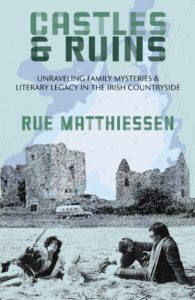
 Rue Matthiessen
Rue Matthiessen
Castles & Ruins—A Challenging Narrative.
When I undertook to return to Ireland with my young family to try to find a castle called Annaghkeen, that I had lived near to as a child, I certainly did not have a book in mind. My mother had died forty years before, leaving a beautiful, personal chronicle of our summer there. It was called Annaghkeen, after the castle. My father was still living, and sometimes we talked about that summer, how we had to row from our small island to the landing and our car, to just get groceries or make a phone call, and how far away from New York it had felt. This led to the idea that, with my husband and our son, I might travel there to find the castle again, still looking out over the island and house, as it did in my memories. We had no map or location for the castle, it wasn’t yet on Google maps. There was just my mother’s book, and her journals and poems, and family archives back home—not much to go on.
My son was just six, about the age I was when I lived had lived there. My husband was a teacher so he was able to travel. Not long after we touched down in Shannon, I could feel atmosphere of the earlier time all around me, and that just became stronger as we traveled. Annascaul, Dingle, Bantry, Dublin—memories of my parents and my odd, fragmented childhood unspooled every day. Of course, I started writing about it. I soon had reams and reams of pages. The trip to find the castle had turned over so much of the past that it would have been impossible for me not to write, and then I thought that I might have a book in it.
I approached it just as a stand alone journal, which didn’t work. Much that needed to be claimed, revealed, and to some extent, understood, was bracketed by two trips, the earlier one when I was seven, and the later one with my own family. It was very difficult to enable these story lines, time frames, and places to run concurrently. Over a long period of time, working on it every day, two essential pieces fell into place. First, the narrative would have to be the real time of our journey, and be continually pegged there. Second, I decided to use passages of my mother’s book, Annaghkeen, to open every chapter. Usually, the passages had relevance to either the emotional context or the setting of the chapter (Cong, Bantry, etc.) or both. This was a thrilling way to write, because it ended up being like having a conversation with my mother who had been gone so long. An added benefit was that her writing style was so very different than mine, that it further deepened the story of us, and allowed the reader to understand who she was independently of us.
I should add that this was a painful book to write, and very emotional for me as the narrative unfurled. It really was as if I was being guided by the story and the characters, (oddly, even my own “character”). The only thing required of me was the patience, the time, and the strength. As I was putting it all together, I often had the thought, “This is why books are so important, and if they’re worth their salt, gain importance over time.” Unfortunately, my father did not live to see the finished Castles & Ruins. He did love the title. He often said of my mother’s book Annaghkeen, that it should be back in print.
It is satisfying to me that to some degree, Annaghkeen is back in print, her passages juxtaposed with mine.
Rue Matthiessen January 29th, ‘24
From Castles & Ruins Pub Date: February 21st, 2024
“Hey, let’s go see Cong,” said Steve, with a humorous twinkle in his eye.
Across the road we found Emmett throwing stones. Above his head they flew in an arc one by one, landing in the water with a soft glug. There was still plenty of daylight, a wide sluice of sun on the river’s Eastern flank. Like a town in the foothills of a mountain range, we could hear water bubbling and coursing almost everywhere. But there were no mountains here. The source is the neighboring lake, Lough Mask, almost as big as Lough Corrib, and thirty-three feet higher. The massive Lough Mask actually vanishes underground at different points along its southern bank, and flows for three miles before rising to the surface in pools and streams around Cong. It does this “now you see me now you don’t” act in perpetuity, never failing so far as history stretches to drop into the earth and wend its way through subterranean waterway and cave, carving ever larger tunnels and caverns from the limestone. It then surfaces at Cong in the form of this and other rivers, before emptying into Lough Corrib.
The mucky bottom was just a few feet down, the water clear as glass. According to the Wilde book, this was once a mill depot, to which the Abbey owed its early patronage. The working Abbey had a stone “Fish House,” perched about a third of the way out. In the time of the monks there was a canal beneath it with a fish trap, to which a bell was attached. My mother found this fascinating.”
